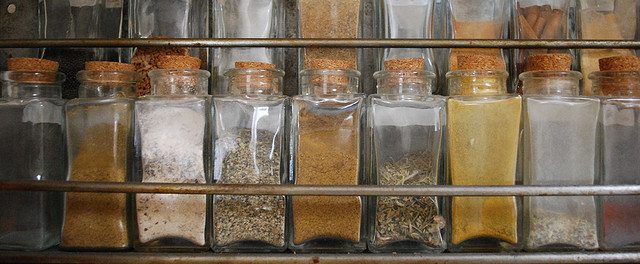~
*Dear elephant reader: if you’re single & looking for mindful dating or conscious love, try out our lovely partner, MeetMindful.
~
Living in a stressful world, I am always looking for ways to feel calmer and more upbeat without resorting to medicines and their sometimes myriad side effects.
Medications usually left me feeling more anxious and just generally out of sorts. This went on for a good number of years before I decided to look for other paths to happiness and came upon food as mood medicine, which I believe is the way nature intended it.
I learned many helpful tips along the way. First and foremost, eliminating sugar from my diet and eating as many whole foods as possible always leaves me feeling energized. It seems so basic, but really works to help me feel better.
I also learned the mood-boosting value of herbs and spices. Taking a whiff of peppermint oil or drinking chamomile tea has always been very soothing. In their book, Healing Spices: How To Use 50 Everyday and Exotic Spices To Boost Health And Beat Disease, Bharat B. Aggarwal, Ph.D. and Debora Yost report trials where students using peppermint oil to calm them down do better on tests than students without it. Lemongrass oil is supposed to be calming as well (1), but I have yet to experiment with it.
Sometimes after a nerve-racking day, I will lavish in a lavender oil bath that is soothing and washes away the stress of the day. I was given a lovely gift of a homemade dried lavender-filled eye pillow, which has a wonderfully soothing effect. I would much rather consider peppermint and lavender oil over anti-anxiety medications because they are not addicting, and do not slow our mind and bodies down.
I have also learned to cook with mood-boosting herbs and spices. Some of my favorites are rosemary and turmeric, which can have anti-depressant effects (1). Fresh rosemary is delicious in salad dressings and grilled with sweet potatoes. I usually add turmeric to smoothies, egg salad, and cauliflower dishes.
Nutmeg is a particularly good spice for anxiety (1). I add it to maple syrup or smoothies, but you can experiment with a variety of dishes from soups to eggs to stews. Aggarwal and Yost suggest only a quarter teaspoon a day and not to overdo it when it comes to nutmeg.
One of favorite spices to add to non-cooking dishes is cinnamon. I love it in smoothies, sprinkled on oatmeal or fruits, especially apples and bananas. Cinnamon helps to balance blood sugar and in this way keep our moods on an even keel (1).
Sage is another mood-boosting spice. Aggarwal and Yost recommend 300 mg a day of sage extract. They also report its benefits for concentration and memory. I must admit that I have never spiced with sage, but it would be worth it when considering how easy it can be to lose focus of our information-flooded world. Growing older certainly can deplete a brain cell here and there.
Coriander has been used to help with anxiety, depression, and even panic attacks. Aggaral and Yost also mention its blood pressure lowering and blood thinning effects. While this may work well for some people, it may not work well for others—certainly not for me since I have unusually low blood pressure to begin with.
When experimenting with herbs and spices, it’s important to do your homework. While most of them are safe, always look up the potential side effects. Never overdo it, which is often our inclination when trying to feel better. When cooking with spices, I was always advised to add them toward the end of cooking for the best flavor and potency. Good, sound advice.
For myself, whole foods, mood spices, and a good dose of exercise and healthy friendships keep me pretty much on an even keel. This makes it easier to accept and face down or unusually stressful days. Adding all of these ingredients as much as I can is usually enough to give a good mood boost, and just enough to find meaning and joy in life.
“Let food be thy medicine and medicine be thy food.” ~ Hippocrates
~
References:
Aggarwal, B. & Yost, D. (2011) Healing Spices: How To Use 50 Everyday and Exotic Spices To Boost Health And Beat Disease. New York, New York: STERLING.
~
Author: June Rousso, Ph.D., M.S.
Editor: Caroline Beaton
Image: Flickr/Brianna Lehman











Read 0 comments and reply